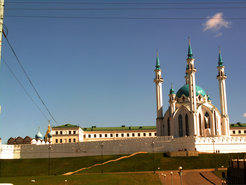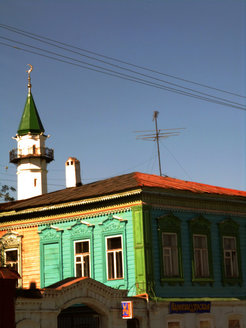Kazan - City of cultures
by Paul Becker
In 2003, my first year at the university coincided with the „Year of Russian Culture in Germany “. Over the course of this event, the German Union of West-East Associations organized a ”German-Russian ship of culture“, where artists, musicians, politicians, and scientists from both countries crossed Germany together via the Rhine, Main, and Danube rivers. En route, there were concerts, panel discussions, and other cultural events hosted in various cities. I was fortunate enough to get an internship with the organization and gather experience in the implementation of such an event.
2004 was proclaimed ”Year of German Culture in Russia”. This time, I was responsible for not only the organizational work during the preliminary stages of the trip, but also for operations on the ship during the second part of the journey.
Over the course of a four - week tour, our ship crossed three federal districts and stopped in twelve cities across Russia - including Kazan, the capital of the Autonomous Republic of Tatarstan. In this blog post, I would like to share with you my experiences in Tatarstan from this leg of the journey.
Moscow welcomed our arrival on (September 9th, 2004) with sleet and temperatures of -1 °C. To give you a sense of the sheer size of the country, it is at this point worth mentioning, that 1500 km and 15 days later, we enjoyed a lunch of 10 kg Astrakhan watermelons at 30 °C.


After a six-hour stay in the newly restored Kazan station in Moscow, our journey to the capital of Tatarstan continued at (12:05 AM) by train. On the way, we enjoyed an obligatory tea brought by a conductress and various purchases from the local babushkas at the smaller stations (the homemade pies with leek and eggs were particularly delicious). Finally, we reached our destination around noon.
Tatarstan's population reflects both the historical diversity of the region and modern migration processes on the territory of the Russian Federation. The Turkic people of the Volga Tatars represent just over half of the population of Tatarstan while around 40% are Russians. The remaining 10% of the population, according to the 2010 census, fall into well over 200 different ethnic groups, some of which have had a presence in the Russia for centuries, and some of which that have just recently immigrated to the country.
97.29% of Tatarstan's population masters the Russian language. However, Tatarstan's government began taking successful steps in the 1990s to revitalize Tatar; the last All Russian census in 2010 showed that 92.43% of Tartars and approximately 3.6% of Russians in Tatarstan had also mastered the Tatar. Tatarstan offers, like many other regions in a multi-ethnic state, some interesting combinations of ethnic, linguistic, and religious backgrounds.
Like the Volga Tartars, 116 thousand Chuvash people representing the third largest population group in Tatarstan belong to a Turkic ethnic group. Their language is the last surviving member of a Bulgarian Turkic language and is based on the Cyrillic alphabet. However, contrary to the Volga Tatars (who are predominantly Sunnites), the Chuvash people belong to the Russian Orthodox Church. Likewise, the Kryashens, long assumed to be an offshoot of the Volga Tatars, speak a middle dialect of the Tatar language but are mostly Russian Orthodox.
During our visit, preparations for the 1000-year anniversary of Kazan were visible everywhere. Kazan, it seemed, was one giant construction site: everything was being built, rebuilt, and embellished. Thanks to the large oil revenues, which remain largely in Tatarstan, no efforts or expenses have been spared - not even the busses of the public transportation system have escaped the celebration.
Despite the long history of military conflicts in Kazan during the middle Ages, the Republic is an integral part of the Russian Federation and a showpiece of almost Soviet-style friendship between the various nations within Russia. This is not to be taken for granted, especially when considering the period of political independence Tatarstan went through in the early 1990s. From 1991 until the signing of the Delegation of Powers pact in 1994, Tatarstan was a de facto independent state. Long negotiations between President Yeltsin and Tatarstan’s then - President Shaimiyev resulted in the granting of a broad autonomy, thus effectively dissolving the independence movement in Tatarstan.
Unlike other secessionist conflicts in the territory of the former Soviet Union, the situation in Tatarstan was always stable. Perhaps the best symbol of the peaceful coexistence between the religions and people of Tatarstan is the Kazan Kremlin itself. Here, the oldest Russian Orthodox Church and the biggest Sunni mosque in Tatarstan are less than 100 meters away from each other within the Kremlin walls.


In addition to its importance to the Russian Orthodox Church as a long host of one of the most famous and sacred Russian icons of the Blessed Mother of Kazan, the city is also a prominent city for Islam in Russia. Traditional Islam, taught at Kazan University, enjoys the greatest number of followers among the Muslims in Tatarstan. Besides Sunni Islam and Orthodoxy, the city is also a haven for other great religions, such as Shiism, Buddhism, Krishnaism, Judaism, Catholicism, and Protestantism.

During our visit we were, among many other things, warmly welcomed into a Shiite mosque, mostly used by Azerbaijani immigrants to Kazan, which has since 1872 been protected and conserved as an urban heritage site. In retrospect, my visit to Tatarstan and the visual impression it made upon me, kindled for the first time my scientific interest in ethnic and religious relations, and has crucially influenced my scientific orientation.
















